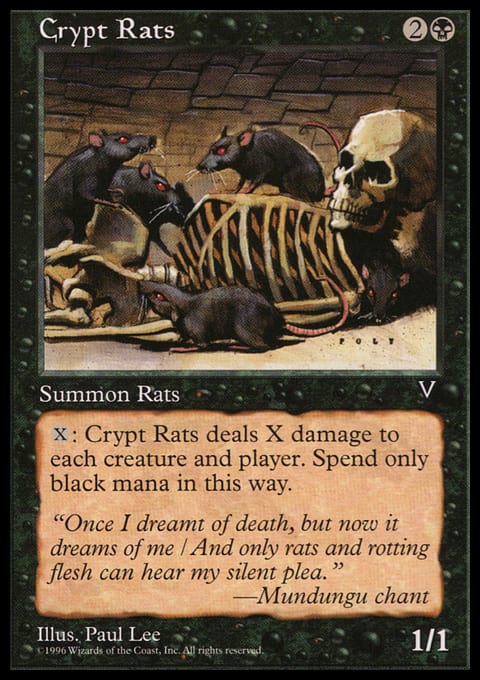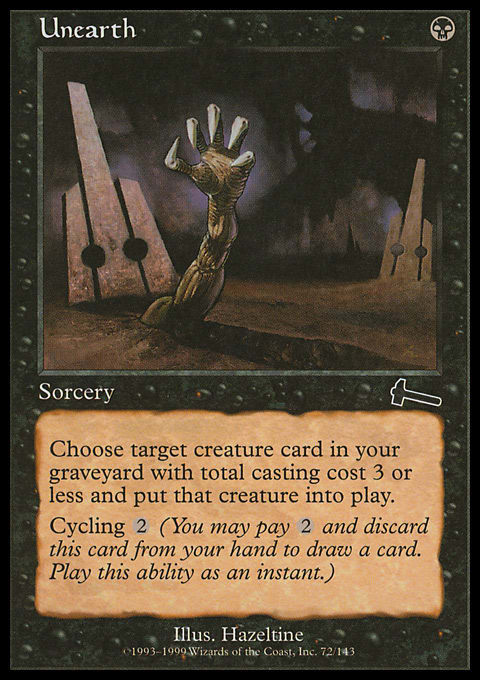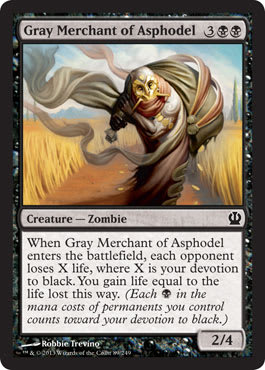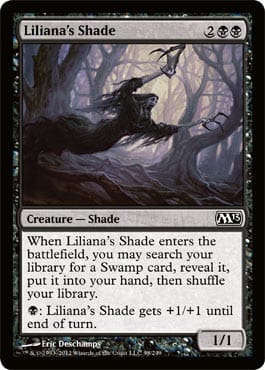Shadows over Innistrad is still a few days away from being released on Magic Online, so while the rest of the world is adjusting to the newest cards, we have to wait patiently. The lull affords an opportunity to examine one of the more consistent archetypes in the format: Mono-Black Control. Why look at Mono-Black? The current metagame has both Delver and Stompy rising in popularity, and while playing Swamps is not a surefire way to beat both of these strategies, the deck can be built to effectively combat both threats. Mono-Black is a highly flexible shell that can be tuned to suit most threats Pauper can present. But before we can look at black’s place currently, we have to understand how the deck tries to win.
And already, we come to a fork in the road. The release of Theros and the printing of Gray Merchant of Asphodel changed the nature of Mono-Black. Or, rather, it returned Mono-Black to its earliest roots. Black decks in Pauper have almost always been centered on value creatures—Phyrexian Rager and Chittering Rats are the two most iconic members of this brigade, as they have been present since the earliest days of player-run events on Magic Online. The goal was to string these creatures together and accrue card advantage until a game-ending Corrupt or Consume Spirit could be resolved. Gravedigger and Twisted Abomination were key elements in the early days, and they represent the two poles: card advantage and game-ender. The core of the deck was solid, and this aided the deck in taking down the first two Pauper Premier Events.
Mono-Black Control ? Pauper (circa 2009) | SlashRus
- Creatures (22)
- 2 Okiba-Gang Shinobi
- 4 Chittering Rats
- 4 Crypt Rats
- 4 Phyrexian Rager
- 4 Twisted Abomination
- 4 Warren Pilferers
- Spells (14)
- 3 Tendrils of Corruption
- 4 Diabolic Edict
- 3 Distress
- 4 Corrupt
- Lands (24)
- 24 Swamp
- Sideboard (15)
- 1 Death Denied
- 1 Distress
- 3 Dross Golem
- 4 Duress
- 4 Echoing Decay
- 1 Okiba-Gang Shinobi
- 1 Tendrils of Corruption
The above deck was a sledgehammer. The newly recognized format was full of rogue creature strategies and hardly realized control decks, so the ability to consistently gain card advantage was huge. The rock-solid mana base also allowed Mono-Black to run one of the more efficient board wipes in the format: Crypt Rats.
How good was Crypt Rats back in the day? After the second Premier Event (also won by Mono-Black), the popular Pauper forums of the day erupted, calling for the card to be banned. Spoiler alert: It never happened.
Mono-Black’s reign did not last long. Zendikar saw Goblin Bushwhacker enter the fold, and Goblins surged to the top of the standings. Why? Bushwhacker gave the deck the ability to win from nowhere, but what really mattered was the presence of Mogg Raider and Goblin Sledder. These two cards could shut down one of Mono-Black’s greatest assets: the life-gain from Tendrils of Corruption. Now Mono-Black could no longer rely on its life total as a replenishable resource.
Goblin Bushwhacker is the first real pivot point in the development of Mono-Black. The list above is not so far off from a devotion-based build, replacing black mana symbols with Swamps. Tendrils of Corruption was often two turns worth of tempo back in the day and could provide a large enough buffer until chaining Corrupts was a reasonable endgame. The Swamps plan had this significant advantage and is one of the reasons the deck won out over versions that splashed blue off Dimir Aqueduct for Mulldrifter or Probe. The earliest days of dominance came before Sign in Blood was printed, so all the card advantage black could muster was attached to creatures.
Sign in Blood gave Mono-Black a chance to start churning through cards on the second turn. Whereas before that turn was saved for either Augur of Skulls, Ravenous Rats, or Distress, the black deck now had a potent turn two play that could pull it ahead of opponents. The same year that saw Sign in Blood’s first printing saw Urza’s Legacy released on Magic Online. With the second set in Urza’s block, black received a gift in Unearth. Mono-Black was already a deck that ran plenty of cheap creatures, and Unearth fit the deck perfectly.
The top decks in Pauper all seek to cheat mana in some way. Delver leverages Islands for Gush and Spire Golem, while Affinity uses its mana base to cast key spells on the cheap. Stompy has access to Quirion Ranger to reset land drops and quickly deploy 1-drops. And Tron—well, it has Tron. Unearth allows Mono-Black to cheat on mana, but in a different manner. Unlike these other strategies, black has to do more than simply playing its normal game plan to be able to achieve the discount. Because of this, Mono-Black will play defense early and will trade off its 3-drops until it can start deploying multiple creatures a turn. Unearth gave Mono-Black a spell that lets the deck “cast” two card-advantage creatures in a turn.
It is hard to understate how important this development was to Mono-Black. Now a turn-four Phyrexian Rager represented whatever had died the previous turn. A turn-three Chittering Rats could linger on the board, stranding opposing Lightning Bolts for fear of further setbacks. Unearth changed the pace of play for Mono-Black and gave the deck the what it needed to evolve once more.
Now packing both Sign in Blood and Unearth, Mono-Black Control became something akin to the Rock, Jund, and Abzan. Mono-Black was a value-based deck with access to excellent removal and reasonable card advantage. Black was no longer going to beat you over the head with a game-ending Corrupt; instead, it would use its creatures to generate persistent advantage over the course of the game. The player who did to most work on this style of deck went by SneakAttackKid.
Mono-Black Control ? Pauper (circa 2013) | SneakAttackKid
- Creatures (19)
- 2 Okiba-Gang Shinobi
- 3 Augur of Skulls
- 3 Crypt Rats
- 3 Ravenous Rats
- 4 Chittering Rats
- 4 Phyrexian Rager
- Spells (18)
- 2 Echoing Decay
- 4 Geth's Verdict
- 2 Duress
- 3 Unearth
- 4 Sign in Blood
- 3 Dead Weight
- Lands (23)
- 17 Swamp
- 2 Polluted Mire
- 4 Barren Moor
- Sideboard (15)
- 1 Okiba-Gang Shinobi
- 2 Rendclaw Trow
- 1 Snuff Out
- 1 Sorin's Thirst
- 2 Tendrils of Corruption
- 1 Victim of Night
- 4 Choking Sands
- 2 Corrupt
- 1 Duress
The next big step in the progress of Mono-Black was the release of Theros. Gray Merchant of Asphodel arrived at the same time Oubliette was bugged online. The enchantment would permanently exile whatever it targeted and quickly became a staple in Mono-Black. Even after the bug was repaired, the ability to add pips to the battlefield proved to be strong enough to keep Oubliette in the game. Cuombajj Witches found their way into the deck as a way to combat Delver of Secrets and Cloud of Faeries, and Pestilence would occasionally worm its way into the main as a way to keep the board clear while also bolstering Gray Merchant. Vintage Masters saw Chainer's Edict printed at common, which provided another source of card advantage for Mono-Black. Fate Reforged gifted the deck a cheap way to end games in Gurmag Angler, but for the past two-plus years, the standard flavor of Mono-Black has been about taking the road to Asphodel.
Mono-Black Control ? Pauper | WontSpendMoney, 5?0 in the Pauper League 4/4/16
- Creatures (19)
- 1 Crypt Rats
- 2 Gurmag Angler
- 4 Chittering Rats
- 4 Cuombajj Witches
- 4 Gray Merchant of Asphodel
- 4 Phyrexian Rager
- Spells (18)
- 1 Victim of Night
- 2 Tendrils of Corruption
- 3 Disfigure
- 1 Unearth
- 4 Chainer's Edict
- 4 Sign in Blood
- 1 Pestilence
- 2 Oubliette
- Lands (23)
- 18 Swamp
- 1 Haunted Fengraf
- 4 Barren Moor
- Sideboard (15)
- 1 Dead Weight
- 3 Duress
- 1 Font of Return
- 2 Shrivel
- 2 Wrench Mind
- 3 Bottle Gnomes
- 3 Choking Sands
Whereas SneakAttackKid’s Mono-Black (hereafter Rats) was about trading resources early to gain card advantage later, builds similar to WontSpendMoney’s (hereafter Devotion) are about establishing a board presence and keeping it until Gray Merchant of Asphodel can hit the board. While there is significant crossover in the cards these decks want to run, the fact remains that these game plans are fundamentally different in how they want to go about ending the game. Rats wants to leverage card advantage, while Devotion wants to go over the top. It is not that one of these game plans is inherently better than the other—it is that they ask for very different decks and should be built as such.
Looking at Devotion, we see it is possible the deck can push for higher-impact copies of Gray Merchant. Unearth is a fine card, but in these decks, is it better than Font of Return? Font of Return represents more cards and has the added benefit of providing an all-important skull. Seal of Doom looks far more attractive as a deterrent when it adds to the endgame. Phyrexian Rager is a great card, but Cadaver Imp can “draw” a card in the late game as well. Liliana's Specter is often included in these decks, but Liliana's Shade can find that fifth Swamp while also providing a late-game threat.
I am more inclined to look at Rats builds. Why? The rise of Devotion coincided with the overwhelming dominance of Delver and Esper Combo. During this time period, it was of the utmost important to take out 1/1 flying creatures (hence Cuombajj Witches). More than that, decks of this era all had to focus on enacting their game plans at a greater speed and consistency than that of their opponents. Resolving a large Gray Merchant of Asphodel made sense, as it was the culmination of committing to the board. Currently, I am less certain this is the best way to build a black-based control deck, as the ability to interact has gained tremendous value. It is not that Devotion Black cannot interact, it is just that it does so at the cost of the Gray Merchant plan. Once we remove the reliance on the Theros common, a variety of possible paths open. One of these routes involves more than one color.
In the past, it was not that there was no good reason to splash, it was that doing so came at the cost of a strong mana base. Look back at SlashRus’ deck—it needed Swamps to operate. In the past seven years, the mana available to Pauper has grown significantly better with Guildgates and gain lands. If a deck is no longer dependent on having a mono-Swamp mana base or on building toward devotion, a black-based value deck can emerge that adds another color for flexibility. My first foray into this version of black control, to the surprise of no one, led me to adding green and Pulse of Murasa.
Pulse of Murasa might be the best Pauper card from the past year. Gaining 6 life is no joke, as it represents at least one turn of attacks. Bringing back a creature is wonderful, especially when that creature is Chittering Rats or Liliana's Specter. The cost of adding Pulse to an otherwise-mono-black deck is incredibly low with cards like Jungle Hollow and Golgari Rot Farm. Another advantage of adding green is the ability to run Wickerbough Elder in the main deck as way to fight random enchantments—a card type that often gives black fits.
Murasa Black ? Pauper | Alex Ullman
- Creatures (18)
- 2 Crypt Rats
- 2 Phyrexian Rager
- 2 Thrull Surgeon
- 2 Wickerbough Elder
- 3 Gurmag Angler
- 3 Liliana's Specter
- 4 Chittering Rats
- Spells (20)
- 2 Grasp of Darkness
- 2 Unmake
- 3 Pulse of Murasa
- 3 Chainer's Edict
- 3 Unearth
- 4 Sign in Blood
- 3 Dead Weight
- Lands (22)
- 13 Swamp
- 1 Barren Moor
- 1 Bojuka Bog
- 1 Slippery Karst
- 2 Golgari Rot Farm
- 4 Jungle Hollow
- Sideboard (15)
- 3 Duress
- 3 Cuombajj Witches
- 2 Faceless Butcher
- 2 Relic of Progenitus
- 1 Crypt Rats
- 1 Chainer's Edict
- 1 Dead Weight
- 1 Font of Return
- 1 Wickerbough Elder
I have been having success with this deck (and similar builds) in the Pauper League. It plays far more like Rats than Devotion and has the ability to generate quite a bit of card advantage. Pulse of Murasa may not have a 2/4 body attached, but it can gain life on its own while also retrieving the right tool for the job. Wickerbough Elder has been a standout, as it can eat Spire Golem, Curse of the Bloody Tome, Journey to Nowhere, and others while leaving a 4/4 behind.
The advances in the mana available have opened up deck-building possibilities in Pauper. In order to see what may exist, however, assumptions have to be cast aside. Mono-Black Control has come a long way, but in the end, it was always a deck based on Swamps. Now that no longer has to be the case. While a powerful Devotion deck exists, that is no reason Bloodfell Caves and Scoured Barrens should be left alone.
So which path do you choose—value or devotion? Swamps or other? No matter what you answer, the next question should be: Am I running the best version or am I just relying on what others have told me? Build toward your own victory, not toward what has won for others.






























